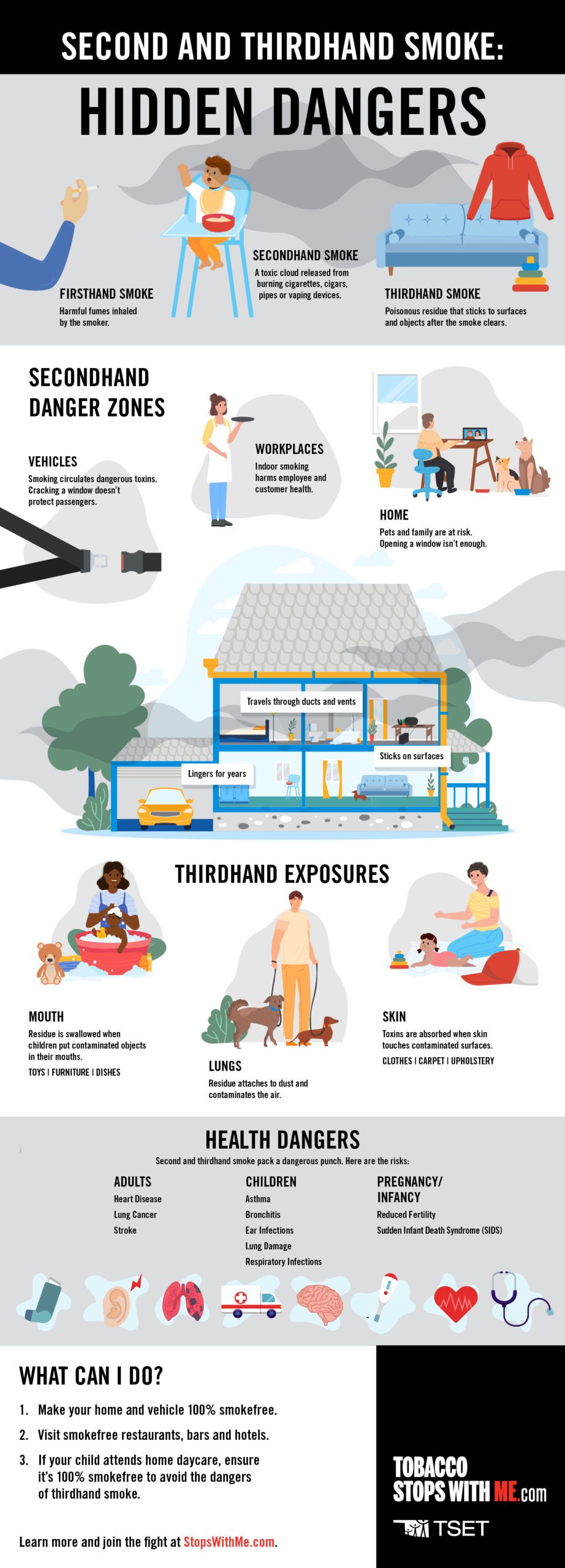First, Second and Thirdhand Smoke: The Differences and Dangers
Everyone knows about secondhand smoke — but what about thirdhand? Let’s break down the differences and look at the unique dangers of each.
Firsthand Smoke
It’s not a term you hear a lot, but firsthand smoke is the stream of smoke inhaled directly by the person using the tobacco product. It comes from cigarettes, cigars, pipes, hookahs and vaping devices. The deadly dangers of firsthand smoke have been documented for decades. Here are just a few:
- Lung Cancer
- COPD
- Heart Disease
- Stroke
- Asthma
- Diabetes
- Blindness
Despite the dangers, more than 567,000 Oklahoma adults and nearly 20,000 high schoolers are current smokers. Those figures don’t include more than 60,000 high school students who are addicted to e-cigarettes and vaping devices. That’s enough to fill EVERY seat in Oklahoma State’s football stadium — with high school vape users alone!
Secondhand Smoke
Secondhand smoke is a combination of two things: 1) the smoke exhaled from the lungs of a smoker and 2) the smoke that drifts from burning tobacco and vapes. This deadly toxin contains more than 7,000 chemicals — 70 of which are known to cause cancer.
Secondhand smoke is disastrous to the health of nonsmoking bystanders. Just 30 minutes of exposure can cause heart damage similar to that of a smoker. Secondhand smoke kills nearly 50,000 nonsmoking Americans each year — and yet, Oklahoma children and workers STILL aren’t protected from its dangers.
In Oklahoma, it’s still legal to smoke in bars and hotels. It’s even legal to smoke with children who are trapped inside a vehicle with adults. Children who are exposed to secondhand smoke face serious, lifelong health consequences — and they are much more likely to become adult smokers.
Thirdhand Smoke
Thirdhand smoke is a toxic residue that contains nicotine, carcinogens and heavy metals like arsenic, lead and cyanide. It’s produced when firsthand and secondhand smoke settle onto surfaces and objects. This residue builds up on clothes, furniture, drapes, walls, bedding, carpets, dust, vehicles and other surfaces.
People can be exposed to thirdhand smoke in several ways. Contaminated dust wafts into the air and is inhaled into the lungs. Thirdhand smoke also attacks the skin. Pets are vulnerable to the negative effects of these harmful toxins when they come in contact with contaminated surfaces.
Thirdhand smoke can also be ingested orally. This often happens when small children place toys, objects or their own hands into their mouths. Contaminants are absorbed by the digestive system where they enter the bloodstream. This is especially concerning in Oklahoma, where smoking is still allowed in home daycares. Daycare operators are prohibited from smoking while children are present, but that doesn’t protect kids from toxic residues that contaminate the daycare environment.
A Common Thread
The scientific evidence couldn’t be clearer: tobacco is the single deadliest product ever created. It’s brimming with natural and artificial toxins, and everything it touches becomes dangerously contaminated — from the air to the environment to the human body itself.
A Call to Action
Now that you know the dangers of second and thirdhand smoke, you can take proactive steps to protect yourself and your family. Make your home and vehicle 100% smokefree, and steer clear of dangerous environments like bars, restaurants, hotels and daycares where smoking is allowed. With some commonsense precautions, you can help your family avoid toxic tobacco byproducts — and the serious health problems they cause. Want to stay current on the latest tobacco news? Get updates, blogs, fascinating articles and more in our newsletter. Sign up today to score free stickers!








